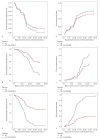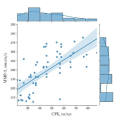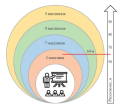ADDRESS TO THE READERS
ARTERIAL HYPERTENSION
The most common cardiovascular disease (CVD) and risk factor for the main causes of death is hypertension (HTN), the prevalence of which in Russia is 44%. The combination of HTN and chronic respiratory diseases (CRDs) can lead to mutual influence and worsen the prognosis.
Aim. To study long-term outcomes in HTN patients with CRDs under outpatient monitoring in primary health care.
Material and methods. This prospective observational study of hypertensive outpatients (n=156, age, 63,4±8,8 years, men, 27,6%) was carried out, of which 49 had asthma, 20 — chronic obstructive pulmonary disease (n=69; group with CRD). The composite primary endpoint included death, myocardial infarction, cerebral stroke, transient ischemic attack, arterial revascularization, angina pectoris, peripheral arterial disease (>50% stenosis), heart failure, atrial fibrillation, and ventricular premature beats >30 h. There were following secondary endpoints: hypertensive crisis, hospitalization, emergency call and temporary disability due to cardiovascular diseases, asthma, chronic obstructive pulmonary disease, pneumonia, chronic respiratory failure. In addition, the following tertiary endpoints were analyzed: increased blood pressure (BP) without a hypertensive crisis, which required correction of HTN therapy, deterioration in CRD course (an increase in the ACQ-5 or CAT total score without exacerbation), acute bronchitis, other acute diseases and exacerbations of chronic ones, which required hospitalizations, new clinically significant chronic diseases not included in the primary and secondary endpoints.
Results. The follow-up period was 29±8 months. The groups did not differ in relation to prevalence of primary endpoints. The frequency of secondary and tertiary endpoints was higher in the CRD group due to "respiratory" events and episodes of BP destabilization requiring correction of HTN therapy (p<0,01). In HTN patients with CRDs, cumulative survival was lower, and the cumulative risk of adverse events was higher.
Conclusion. Larger studies are needed in this area, as well as an analysis of the factors associated with adverse outcomes in hypertensive patients, including BP characteristics and accounting for CRDs, in order to improve preventive approaches.
Aim. To compare the effect of atorvastatin and rosuvastatin as part of complex therapy in patients with hypertension (HTN) with a high cardiovascular risk on the level of matrix metalloproteinases -1, -9 (MMP-1, MMP-9) and tissue inhibitors of metalloproteinases -1, -4 (TIMP-1, TIMP-4).
Material and methods. The study included 140 hypertensive patients who received atorvastatin (Liprimar) 20 mg/day in addition to antihypertensive therapy for a year, which was later replaced by rosuvastatin (Rosucard) in the following doses: 10 mg/day (n=96), 20 mg/day (n=24), 40 mg/day (n=26). Patients underwent standard clinical and paraclinical investigations. In the blood serum of patients, the levels of MMP-1, MMP-9 and TIMP-1, TIMP-4 were determined.
Results. Patients who used rosuvastatin at a dose of 40 mg/day had a more pronounced decrease in MMP-1 than those treated with rosuvastatin at a dose of 10 and 20 mg/day (p<0,05), while there were no differences in MMP-1 when using low and medium doses. Rosuvastatin had a less pronounced effect on MMP-9 than on MMP-1, while increasing the dose of rosuvastatin did not affect the intensity of MMP-9 reduction (p>0,05). The content of TIMP-1 and TIMP-4 increased when taking rosuvastatin, while a more pronounced dose-dependent increase in TIMP-1 was observed with rosuvastatin 20 mg/day and 40 mg/day. In addition, the largest increase in TIMP-4 was observed when using rosuvastatin at a dose of 40 mg/day. Atorvastatin had no significant effect on MMP-1 and MMP-9, as well as TIMP-1 and TIMP-4.
Conclusion. Long-term rosuvastatin therapy (10 mg/day, 20 mg/day, 40 mg/day) as part of the complex therapy of cardiovascular patients affects the metabolism of vascular wall elastin and collagen, reducing the level of MMP-1, MMP-9 and increasing the content of TIMP-1, TIMP-4 in the blood.
CORONARY HEART DISEASE
Aim. To analyze myocardial revascularization in patients with acute and chronic coronary artery disease (CAD) and with different glycemic status, as well as to evaluate complications after a 1-year follow-up.
Material and methods. This prospective comparative clinical study included 202 patients of both sexes with acute and chronic coronary artery disease. Depending on the glycemic status and CAD type, the patients were divided into four groups: acute CAD and type 2 diabetes (T2D); acute CAD without T2D (control group); chronic CAD and T2D; chronic CAD without DM2 (control group). Depending on the clinical condition and the results of coronary angiography, patients underwent various types of myocardial revascularization: balloon angioplasty without stenting, stenting, coronary artery bypass grafting, stenting + coronary artery bypass grafting. One year after discharge, all patients were contacted to evaluate complications and endpoints, which included recurrent myocardial infarction, cerebrovascular accident, readmission, revascularization, and death. Total indicator of endpoints was assessed.
Results. Up to 80% of patients with acute and chronic CAD, regardless of glycemic status, underwent revascularization, mainly stenting. The prevalence of stenting among persons without T2D with acute and chronic CAD was significantly higher compared with patients with T2D. The absolute number of patients with coronary artery bypass grafting, including in combination with stenting, was higher in the T2D groups. In groups without T2D, the number of patients with one stent was 2-2,5 times higher compared to groups with T2D — acute CAD (p=0,041) and chronic CAD (p=0,017). The prevalence of implantation of ≥2 stents did not differ between the groups. Within 1 year after discharge, there were more hospitalizations and reoperations among people with acute and chronic CAD and T2D. The groups did not differ in the number of non-fatal and fatal complications, although the absolute numbers of these indicators were higher in patients with T2D. The total number of endpoints in T2D people, regardless of the CAD type, were 2 times higher compared to the corresponding control groups (p<0,001).
Conclusion. Most patients with acute and chronic CAD, regardless of glycemic status, underwent myocardial revascularization. In patients without T2D, stenting prevailed, most often of one coronary artery. Patients with T2D, along with stenting, underwent coronary bypass grafting, as well as a combination of these two procedures. After a year of follow-up, the number of complications in patients with T2D was 2 times higher compared to patients without type 2 diabetes, which emphasizes the importance of secondary prevention, including complex drug treatment.
CHRONIC HEART FAILURE
Aim. To assess the change in the activity of the matrix metalloproteinase (MMP) system after 6-month spironolactone therapy in patients with heart failure (HF) with preserved (HFpEF) and mildly reduced ejection fraction (HFmrEF) after coronavirus disease 2019 (COVID-19).
Material and methods. The study included 90 patients treated at the University Clinical Hospital № 4 of the I.M. Sechenov First Moscow State Medical University with a laboratory-confirmed COVID-19. There were following inclusion criteria: age of 18-85 years; the presence of HFpEF and HFmrEF. The patients were randomized into two groups: group I (n=60) — patients with 6-month spironolactone therapy (25 mg/day) in addition to the standard therapy for HF, spironolactone was taken at a dose of 25 mg/day; Group II (comparison group, n=30) — patients who received standard therapy without spironolactone. All patients were determined plasma MMP concentrations.
Results. There were no significant differences in the levels of matrix metalloproteinase-9 (MMP-9) and tissue inhibitor of metalloproteinase-1 (TIMP-1) between the groups when included in the study. A repeated investigation revealed a significant decrease in the concentrations of MMP-9 and TIMP-1 only in group I. In patients of group II, there were no significant changes in the plasma concentrations of MMP-9 and TIMP-1. The MMP-9/TIMP-1 ratio during the initial examination of patients did not have significant differences. After 6-months therapy, a significant decrease in the ratio of MMP-9/TIMP-1 was observed only in patients taking spironolactone.
Conclusion. The results obtained confirm a significant decrease in MMP system activity after 6-month spironolactone therapy in patients with HFpEF and HFmrEF after COVID-19. The described antifibrotic effects of spironolactone make it possible to recommend the use of this drug in this category of patients to reduce the negative effect of MMPs on cardiovascular system.
STUDIES AND REGISTERS
Aim. To determine the adherence to drug therapy and the prevalence of cardiovascular events (CVEs) in patients with heart failure (HF) after a 1-year follow-up in a specialized cardiology unit of a research center.
Material and methods. CVEs were analyzed within the prospective observational study COMPLIANCE (Assessment of adherenСe tO Medical theraРy and its infLuence on long-term outcomes In pAtieNts with Chronic hEart failure in the outpatient registry). The study included 72 patients with HF, verified according to clinical guidelines. Patients were divided into 2 groups: adherent and non-adherent to treatment. Overall adherence to therapy and adherence to specific drugs were assessed using the original National Society for Evidence-Based Pharmacotherapy
Adherence Scale. The study included 2 visits: inclusion in the study and a visit after 1-year follow-up. After a 1-year follow-up, a comparative analysis of the two groups was performed to achieve the primary composite endpoint: death, acute cerebrovascular accident, myocardial infarction, decompensated HF with and without hospitalization.
Results. A Kaplan-Meier analysis of 1-year survival showed that the mean time to onset of primary composite endpoint was 10,2 (95% confidence interval: 9,5-10,8) months. A significant relationship was found between the occurrence of composite endpoint and adherence to angiotensin-converting enzyme inhibitors/angiotensin receptor blockers (p=0,001), which was not confirmed for beta-blockers and mineralocorticoid receptor antagonists (p=0,338 and p=0,335, respectively). The risk of composite endpoint was 3,6 times higher in non-adherent patients than in adherent patients (hazard ratio, 3,6; 95% confidence interval, 1,5-8,5 (p=0,003)).
Conclusion. A significant relationship was found between nonadherence to treatment and the incidence of CVEs, the risk of which increases by 3,6 times in non-adherent patients compared with adherent patients with HF.
Aim. To analyze the availability and affordability of alcohol and tobacco outlets using the specialized software developed by the National Medical Research Center for Therapy and Preventive Medicine in the pilot subject of the Russian Federation — the Sverdlovsk Oblast.
Material and methods. For the first time, experts from the National Medical Research Center for Therapy and Preventive Medicine conducted a pilot study to assess the actual state of the infrastructure of a separate subject of the Russian Federation (Sverdlovsk Oblast). The study objects were the urban infrastructure elements in which alcohol and tobacco products are sold. In order to assess the infrastructure, special software was developed using Open Street Maps to perform data collection tasks. The infrastructure data collection for the pilot study took place from January to March 2022.
Results. The total number of tobacco outlets is 299, most of which are located in supermarkets (82,6%, n=247). The share of individual tobacco outlets accounts for 13,7% (n=41). Out of 357 supermarkets, 247 (69%) have tobacco sales section. The average lowest price of a cigarette pack is 121,6±15,7 RUB (minimum — 30 RUB, maximum — 207 RUB). Twentyseven (10,9%) of 247 supermarkets located <100 m from educational institutions carry tobacco products. The minimum distance is 64 m. There are 449 alcohol outlets in total, most of them are located in supermarkets — 57,0% (n=256). Individual alcohol outlets account for 40,8% (n=183). Out of 357 supermarkets, 256 (71,7%) have alcohol sales section. Out of 158 individual alcohol outlets, vodka is available in 101 (63%) outlets, wine — in 112 (68,3%) out of 162 outlets, beer — in 112 (68,3%) out of 164 outlets, alcoholic cocktails — in 71 (45,2%) out of 57 outlets. The average lowest selling price of vodka is 255,9±62,2 RUB (minimum — 230 RUB), wine — 180,2±89,3 RUB (minimum — 110 rubles), beer — 51,2±15,5 RUB (minimum — 33 rubles), alcoholic cocktails — 58,9±15,4 RUB (minimum — 37 rubles). In addition, 27 (10,5%) of 256 supermarkets with a liquor section (minimum distance of 64m) are located <100 m from educational institutions, as well as 10 (5,4%) out of 183 individual stores specializing in the alcohol sale (minimum distance of 50 m).
Conclusion. The results obtained with the help of the developed tool can be used as arguments for strengthening monitoring of compliance and making changes to the current legislation that restricts the availability of tobacco and alcohol products. The use of the developed tool will make it possible using evidence to make informed decisions in the development and implementation of public health programs at the municipal level.
Vascular stiffness due to arteriosclerosis reduces arterial elasticity which is as an independent and non-invasive predictor of future incidence of coronary heart disease and stroke. There is limited evidence of the benefits of regular exercise on arterial stiffness in populations suffering from cardiovascular diseases (CVD) especially coronary artery disease (CAD).
Aim. To determine the acute and chronic effects of aerobic, resistance and combined exercise on arterial and hemodynamic function in patients with CAD.
Material and methods. This study will be a prospective, single-blind, randomized study examining the effects of exercise on arterial stiffness. The study will be conducted at a tertiary care hospital for a continuous period of one year. Patients with CAD (n=105) will be selected using systematic sampling techniques and allocated randomly to one of the four treatment groups using computer-generated, random number sequence for age, sex and health status of CAD (Group-I: aerobic exercise, Group-II: resistance exercise, Group-III: combined aerobic and resistance exercise, and Group-IV: control) as per the inclusion and exclusion criteria. All recruited subjects will be informed about the assessment and intervention procedure before getting the consent form filled. This project followed the guidelines of standard protocol for randomized clinical trials (spirit).
Perspective. It is expected that this study protocol shall through light and be helpful in better quality of life along with decline in drug dependency for the people suffering from CAD. Further this study will be valuable is designing exercise protocol for the people suffering from CAD.
OPINION OF INVITED EDITOR
See: Gaurav Kapoor, Avinash Swaroop, Sandeep Singh. Impact of acute and chronic regular exercise on arterial stiffness and reflection measures in coronary artery disease patients: A Protocol for Randomized Clinical Trial in Studies and registers, pp. 57-64.
REVIEW ARTICLES
Patient safety is a discipline that has arisen in response to the increasing complexity of health care delivery and the associated increase in patient harm. Adverse health care events are a serious problem, causing significant harm to the patient and increasing health care costs. The World Health Organization has identified patient safety as one of the key priorities for world health. The current review presents the historical background that led to the formation of the discipline of patient safety, the determinants of adverse events in medical practice, and the main tools for dealing with them.
The use of a systematic approach to the study of the etiology of a certain pathology makes it possible to improve the understanding of its pathogenesis, as well as to develop more effective diagnostic and therapeutic approaches, including improving the prediction of its risk. Within this review, we will consider such an area of interdisciplinary research as neurocardiology, which studies the brain-heart axis. Examples of cardiovascular diseases associated with organic and functional disorders of this axis will be considered, as well as the prospects for research in this area and their translational significance for clinical medicine.
RUSSIAN SOCIETY FOR THE PREVENTION OF NONCOMMUNICABLE DISEASES
INFORMATION
METHODICAL GUIDELINES
Methodological guidelines "Psychoemotional risk factors in outpatient practice" were developed as a practical document for primary care physicians in order to expand and improve knowledge, as well as provide care to the adult population within the studied theme. The methodological guidelines include an information and content part for medical specialists and a practical part for patients, presented in the format of memos. The guidelines include the main sections: definition, structure and epidemiology of psychoemotional risk factors, psychoemotional risk factors in the clinics of internal diseases, screening of psychoemotional risk factors, prevention and correction of psychoemotional risk factors for noncommunicable diseases, non-drug care for patients, pharmacotherapy of psychoemotional disorders. The guidelines are intended for primary care physicians, for specialists who develop and implement educational programs for patients, as well as for therapeutic residents.
ISSN 2619-0125 (Online)
































































